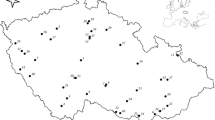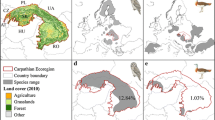Abstract
The Chicago region is a large, established metropolitan region, that may play a critical role for the conservation of breeding and migratory birds in midwestern North America. The region includes over 80,000 ha of protected lands that include some of the best remaining grassland, oak savanna, and marsh habitat in the state of Illinois. Because of its juxtaposition with Lake Michigan, the region serves as a significant stop-over site for spring and fall migrants that comprise a diverse group of terrestrial and aquatic species. Efforts to conserve and restore habitat for birds in the region are being coordinated by a partnership of over 60 public and private organizations known collectively as the “Chicago Wilderness.” These organizations have joined to protect, manage, and restore the habitats and biological communities of the region. Specific activities include ecological inventory, the creation of recovery plans for various types of biologically significant habitats, restoration research, education and outreach, and the identification of region-wide conservation priorities. The benefits of these activities for birds are promising. Studies conducted in lands managed by the forest preserve district of Cook County indicate that the breeding bird communities in the preserves are quite similar to those in the rural areas of Illinois. Moreover, estimated rates of parasitism by Brown-headed Cowbirds (Molothorus ater) are less than those observed in the more agricultural landscapes of the upper midwestern United States. Habitat protection in otherwise developed metropolitan areas may offer significant conservation opportunities in regions where natural habitat is scarce.
Access this chapter
Tax calculation will be finalised at checkout
Purchases are for personal use only
Preview
Unable to display preview. Download preview PDF.
Similar content being viewed by others
References
Beissinger, S. R., and D. R. Osborne. 1984. Effects of urbanization on avian community organization. Condor 84:75–83.
Brawn, J. D. and S. K. Robinson. 1996. Source-sink population dynamics may complicate the interpretation of long-term census data. Ecology 77:3–12.
Brawn, J. D. 1998. Effects of oak savanna restoration on avian populations and communities in Illinois. Final report, Illinois Natural History Survey, Champaign, IL.
DeGraff, R. M., and Wentworth, J. M. 1981. Urban bird communities and habitats in New England. Transactions of the North American Wildlife and Natural Resources Conference 46:396–413.
Fralish, J. S., F. B. Crooks, J. L. Chambers, and F. M. Harty. 1991. Comparison of presettlement, second-growth and old-growth forest on six site types in the Illinois Shawnee Hills. Amer. Midi. Nat. 125:294–309.
Havera, S. P., L. B. Sulloway, and J. E. Hoffman. 1997. Wetlands in the Midwest with special reference to Illinois, p.88–104. InM. W. Schwartz [ED.], Conservation in highly fragmented landscapes. Chapman and Hall, New York, NY.
Herkert, J. R. 1994. The effects of habitat fragmentation on midwestern grassland birds species. Ecol. Appl. 4:461–471.
Hutto, R. L. 1998. On the importance of stopover sites to migrating birds. Auk 115:823–825.
Ilyichev, V. D., V. M. Konstantinov, and B. M. Zvonov. 1986. The urbanized landscape and an arena for mutual relations between man and birds, p. 123–130. In Urban ecological studies in Central and Eastern Europe. Polish Academy of Sciences, Warsaw, Poland.
Openlands Project. 1999. Under Pressure: Land Consumption in the Chicago Region, 1998–2028. Openland Project, Chicago, IL.
Marzluff, J. M., F. R. Gehlbach, and D. A. Manuwal. 1998. Urban environments: influences on avifauna and challenges for the avian conservationist, p.283–306. In J. M. Marzluff and R. Sallabanks [EDS.], Avian conservation. Island Press, Washington, DC.
Mlodinow, S. 1984. Chicago area birds. Chicago Audubon Society, Illinois.
Reichard, S., L. Chalker-Scott, and S. Buchanan. 2001. Interactions among non-native plants and birds, p. 179–223. In J. M. Marzluff, R. Bowman, and R. Donnelly [EDS.], Avian ecology and conservation in an urbanizing world. Kluwer Academic, Norwell, MA.
Robinson, S. K., F. R. Thompson, III, T. M. Donovan, D. R. Whitehead, and J. Faaborg. 1995. Regional forest fragmentation and the nesting success of migratory birds. Science 267:1987–1990.
Robinson, S. K., J. D. Brawn, and J. P. Hoover. 1997. Effectiveness of small preserves for breeding birds, p. 154–188. In M. W. Schwartz [EDS.], Conservation in highly fragmented Landscapes. Chapman and Hall, New York, NY.
Schwartz, M. W. [ED.]. 1997. Conservation in Highly Fragmented Landscapes. Chapman and Hall, New York, NY.
Sullivan, J. 1998. An Atlas of Biodiversity. Chicago Wilderness, IL.
Suloway, L., and M. Hubbell. 1994. Wetland resources of Illinois. Illinois Natural History Survey, Special Publication 15. Champaign.
Taft, J. 1997. Savanna and open woodland communities, p.24–54. InM. W. Schwartz [EDS.]. Conservation in highly fragmented landscapes. Chapman and Hall, New York.
VanDruff, L. W., E. G. Bolen, and G. J. San Julien. 1996. Management of urban wildlife, p.507–530. In T. A. Bookhout [EDS.], Research and management techniques for the management of wildlife, 5th edition. The Wildlife Society, Bethesda, MD.
Wang, Y., and D. K. Moskovits. In Press. Tracking fragmentation of natural communities and changes in land-cover: applications of Landsat data for conservation in Chicago. Wilderness. Cons. Biol.
Warner, R. 1994. Agricultural land-use and grassland habitat in Illinois: future shock for Midwestern birds? Cons. Biol. 8:147–156.
Author information
Authors and Affiliations
Editor information
Editors and Affiliations
Rights and permissions
Copyright information
© 2001 Springer Science+Business Media New York
About this chapter
Cite this chapter
Brawn, J.D., Stotz, D.F. (2001). The importance of the Chicago region and the “Chicago Wilderness” initiative for avian conservation. In: Marzluff, J.M., Bowman, R., Donnelly, R. (eds) Avian Ecology and Conservation in an Urbanizing World. Springer, Boston, MA. https://doi.org/10.1007/978-1-4615-1531-9_24
Download citation
DOI: https://doi.org/10.1007/978-1-4615-1531-9_24
Publisher Name: Springer, Boston, MA
Print ISBN: 978-1-4613-5600-4
Online ISBN: 978-1-4615-1531-9
eBook Packages: Springer Book Archive




